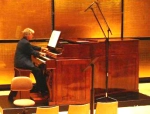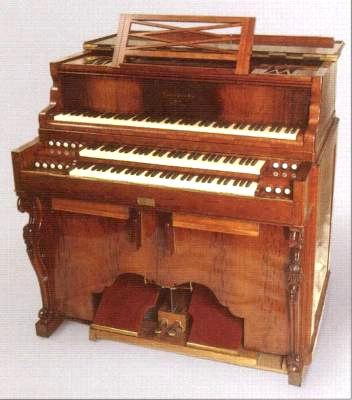In September 1854 Liszt wrote to the cellist Bernhard Cossmann “My monster instrument with three keyboards arrived about a fortnight ago and seems to be a great success.”
The 3000-pound instrument, a seven-octave grand piano plus two five-octave harmonium keyboards, was built by Alexandre Père et Fils and Pierre Érard to Liszt’s specifications. Although the critic Richard Pohl reported having heard the  composer play this piano-harmonium, apparently it was never heard in concert until Joris Verdin (left) presented a recital on the instrument, newly restored by Patrick Collon and the Manufacture d’orgues de Bruxelles 150 years after it was built, at the Wiener Musikverein.
composer play this piano-harmonium, apparently it was never heard in concert until Joris Verdin (left) presented a recital on the instrument, newly restored by Patrick Collon and the Manufacture d’orgues de Bruxelles 150 years after it was built, at the Wiener Musikverein.
In addition to the piano and pumping pedals seen above, the original version included a 20-note pedalboard and an attachment allowing an assistant to pump the bellows while the player used the organ or piano pedals; these are lost and have not been reconstructed.
This according to “Liszt’s monster instrument revisited” by Wayne T. Moore (The diapason XCVI/5 [May 2005] p. 15). Today is Liszt’s 210th birthday!
Below, Professor Verdin demonstrates Liszt’s monster instrument.
More posts about Franz Liszt are here.






 The iconography of the harp in the context of the
The iconography of the harp in the context of the 





